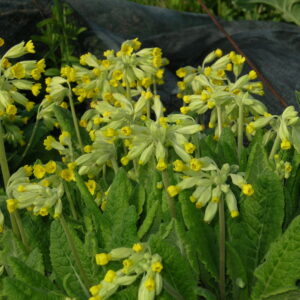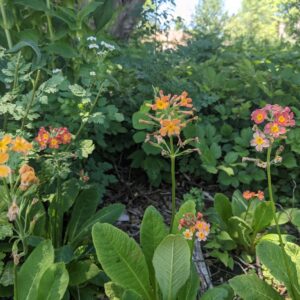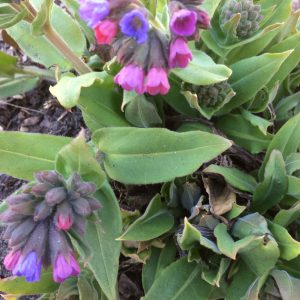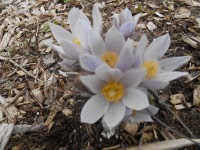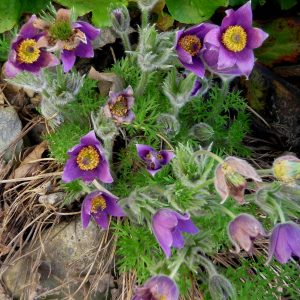Shop
- Sorry, this product cannot be purchased.
Showing 593–600 of 778 results
-
Primula veris Cowslip Z 3-8
Sunniest of yellow trumpet flowers announce the beginning of spring
Sunniest of yellow trumpet flowers announce the beginning of spring.
Size: 8" x 8"
Care: part shade in moist to moist well-drained soil.
Native: Europe
Awards: England’s Royal Horticultural Society Award of Merit and Elisabeth Carey Miller Botanical Garden Great Plant PicksPrimula is Italian “primavera” meaning first spring. Veris is redundant, meaning flowers in spring. According to legend, Cowslip decorated the entrance to Norse goddess Fryda’s palace. The blossoms were used to make wine; a recipe from the 1700’s called for water, sugar, lemon juice, egg whites and a “peck of cowslips.” According to Culpepper, a 1500’s herbalist, cowslip extract made women more beautiful. Cowslip was a favorite Shakespearean plant. Grown at America’s 1st botanic garden, Elgin Botanic Garden 1811. Jefferson received cowslip seeds in 1824. Pressed specimen in Emily Dickinson’s herbarium.
-
Primula vulgaris syn. Primula acaulis English primrose Z 4-8
Primrose yellow blossoms in earliest of spring.
ARCHIVED
Note: This is a plant not currently for sale. This is an archive page preserved for informational use.
Primrose yellow blossoms cheer on the earliest of spring.
Size: 6" x 6"
Care: shade in moist to moist well-drained soil. Immune to Walnut toxicity
Native: Europe
Awards: Received England’s Royal Horticultural Society Award of Merit.Primula is from Italian “primavera” meaning first spring. Vulgaris means common. Grown in the Eichstätt Garden, the garden of Johann Konrad von Gemmingen, prince bishop of Eichstätt in Bavaria, c. 1600. Grown by Jefferson. Grown at America’s 1st botanic garden, Elgin Botanic Garden 1811. Old medicinal uses to cure gout and headaches.
-
Primula x bulleesiana Candelabra primrose Z 4-7
Blooms June-July, a rainbow of colors ranging from red, orange, rose, to cream, lavender and purple
OUT OF STOCK
Blooms June-July, a rainbow of colors ranging from red, orange, rose, to cream, lavender, and purple
Size: 18-24” x 12-18”
Care: Sun to part shade in moist to wet well-drained soil
Wildlife Value: Attracts butterflies. Deer resistant
Awards: Royal Horticultural Society Award of Garden Merit 1993Hybrid cross between Primula bulleyana and Primula beesiana (both parents are native to the Himalayas and China).
Collected in China, introduced to Britain in 1906 -
Pulmonaria angustifolia Narrow-leaf lungwort, Blue cowslip Z 4-8
One of the earliest to flower - Pink turning azure blue, trumpet-shaped flowers in April- May. Fuzzy foliage.
One of the earliest to flower – Pink turning azure blue, trumpet-shaped flowers in April- May. Fuzzy foliage.
Size: 12”x 18”
Care: full to part shade in moist to moist well-drained soil.
Native: Austria & Hungary.
Wildlife Value: walnut tolerant and deer resistant. Early source of nectar for bees.
Awards: Royal Horticultural Society Award of Garden MeritAngustifolia means “narrow leaves.” But its leaves are only narrow compared to the leaves of other Pulmonarias.
Grown in gardens before 1590’s.
-
Pulmonaria saccharata ‘Mrs. Moon’ Greater lungwort, Bethlehem sage Z 3-8
In early spring funnel form pink flowers turn to blue above bristly, white mottled green foliage. Leaves attractive through fall
OUT OF STOCK
In earliest spring funnel form pink flowers turn to blue above bristly, white mottled green foliage. Leaves attractive through fall
Size: 8-18” x 18-24”
Care: full to part shade in moist well-drained soil
Native: species France & Italy
Wildlife Value: walnut and deer tolerant. Early source of nectar for bees.The species originally described by English botanist and gardener to Queen Mary, Leonard Plukenet (1641-1706) .Described by Philip Miller (1768) as having “spotted leaves as if they were incrusted with sugar.” ‘Mrs. Moon’ cultivar offered for sale in 1938 by Gardenside Nurseries in Shelburne VT. Name Pulmonaria from Latin pulmo or lung (e.g.today’s pulmonary) because the blotched leaves were considered to resemble lung disease. Saccharata comes from Latin word for sugar because the white bristly leaves resembled sugar coating.
-
Pulsatilla patens syn. Anemone patens Eastern pasque flower Z 3-7
Up-facing blue-violet bells in early spring emerge from foliage decorated with silky hairs.
ARCHIVED
Note: This is a plant not currently for sale. This is an archive page preserved for informational use.
Up-facing blue-violet bells in early spring emerge from foliage decorated with silky hairs.
Size: 8-12” x 4-6" slow to grow, so be patient
Care: sun in moist well-drained to well-drained soil
Native: northern Great Plains including WI, Siberia, AlaskaThe name Pasque is Old French for Easter referring to the spring bloom time. Patens means “spreading.” South Dakota honors this as its state flower.
Collected for gardens prior to 1753. The Blackfoot made a decoction of this plant to speed a baby’s delivery and applied crushed leaves to skin to remedy irritation. Omaha applied fresh, crushed leaves as a poltice for rheumatism. -
Pulsatilla vulgaris Pasque flower Z 4-8
Nodding, bell-shaped purple petals with yellow centers flowers in early spring. Fun, furry foliage and Medusa-like seed heads.
Nodding, bell-shaped purple petals with yellow centers flowers in early spring. Fun, furry foliage and Medusa-like seed heads.
Size: 8" x 8"
Care: sun in well-drained to moist well-drained soil
Native: Europe
Wildlife Value: Deer resistant, early pollen source for bees.
Awards: Great Plants for Great Plains, Royal Botanical Society Award of Garden MeritCultivated in Europe since at least medieval times. Possibly used by the Druids (about 2000 years ago) in their festival of the dawn goddess. Grown in the Eichstätt Garden, the garden of Johann Konrad von Gemmingen, prince bishop of Eichstätt in Bavaria, c. 1600. Jefferson planted this in 1771 in a shrubbery at Monticello. Called Pasque flower because it blooms at Easter time, well maybe for gardens in Missouri or Maryland.
-
Pulsatilla vulgaris var. ‘Alba’ Z 4-8
Pure white petals of open bell-shape with yellow centers flowers in early spring. Fun, furry foliage and Medusa-like seed heads.
ARCHIVED
Note: This is a plant not currently for sale. This is an archive page preserved for informational use.
Pure white petals of open bell-shape with yellow centers flowers in early spring. Fun, furry foliage and Medusa-like seed heads.
Size: 8-12” x 8-12”
Care: sun to part shade in well-drained to moist well-drained soil
Native: Europe
Wildlife Value: Deer resistant, early pollen source for bees
Awards: Royal Horticultural Society Award of Garden Merit“There is a variety of (Pulsatilla vulgaris) with white flowers…” Gardeners Dictionary, 1768.

